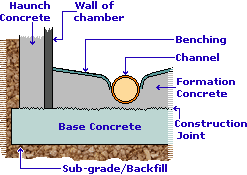Introduction:
Any concrete structure that is going to require numerous movement joints, is best designed by a civil or structural engineer.
All concrete, once placed, will contract slightly during the curing process; this is the primary cause of small surface cracks that appear during the curing process. When set, concrete will expand and/or contract slightly with ambient temperature.
Movement joints are also useful when laying concrete within an area bounded by walls or buildings, or when an object such as a manhole cover has to be incorporated within the slab, as they allow the concrete to expand and/or contract without transferring pressure onto the other structures, causing cracks within the concrete slab, or the wall, MH cover, etc.
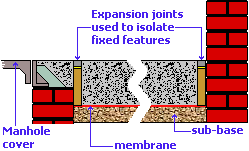
Spacing
The usual recommendation is for some form of movement joint to be created in a non-reinforced slab at a separation of approximately 30 times the slab thickness. So, for a 100mm thick slab, there should be some for of joint every 100m × 30 = 3000mm = every 3.0-3.6m and, in a 150mm slab, 150 × 30 = 4500mm = 4.5-5.4m. Naturally, there is some leeway with these calculations, and joints can be positioned to coincide with band courses or to be 'centred' within a slab for aesthetic reasons.
Types of Joint
Different joints are used for differing purposes:
Expansion joints
- allow expansion AND contraction of a concrete slab without generating potentially damaging forces within the slab itself or the surrounding structures. Expansion joints are usually a complete 'gap' between adjacent bays, ie, there is a definite break in the concrete and any reinforcing steel that may be present. Where adjacent bays are 'tied' together by means of dowel bars, these dowels are sleeved in one of the bays to allow expansion to take place without generating stresses within the slab.
Contraction joints
- also known as 'shrinkage joints', this type of joint allows only for contraction or shrinkage of the slab, as can be anticipated during the curing process.
Crack control joints
- as some wit once remarked, "There are only two types of concrete; that which has cracked, and that which is about to crack." Crack control joints are a partially-formed contraction joint that aims to ensure that when the concrete does crack, it cracks in a predictable manner at a precise location.
Construction joints
Although this type of joint is not a true movement joint, it is a commonly formed joint in concrete construction and so is included here for completeness. Construction joints can be horizontal or vertical and are formed when placement of the concrete is interrupted for some reason. It may be the end of a day's work or it may be that some other work needs to be completed before resuming the placement, but the result is the same - a 'surface' is formed as the placed concrete cures, and then fresh, plastic concrete is poured against this 'surface' as some later point in time.
Materials for Concrete Joints
There are numerous different materials used in forming joints in concrete slabs, but the most common are...
Flexible board:
A fibrous, compressible, flexible board, such as 'Flexcell', It is cheap and readily available from Builders' merchants in pre-cut strips of the required depth, expressly for creating expansion joints. It is typically 12mm, 20mm or 25mm thick and the right thickness for the joint should be chosen. No joint should be wider than 30mm.
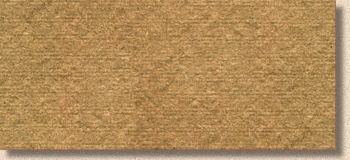
Dowels:
400-600mm long, 20-32mm in diameter and manufactured from Grade 250 steel.
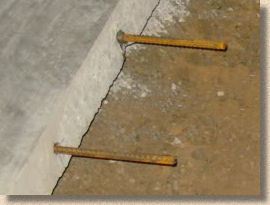
Sealants:
There are three main types:-
- - hot poured, usually bituminous in origin. Not as widely used nowadays as they once were.
- - cold applied - often a two-part polysulphide mix incorporating resin and curing agent such as Colpor 200 or Thioflex. Usually applied via a mastic gun and smoothed with a putty knife. The most commonly used joint sealant.
- - pre-formed elastomeric - expensive and, in trade parlance, a "right bastard" to work with. Need to be squeezed and inserted into a scrupulously clean and well-lubricated, perfectly formed joint.
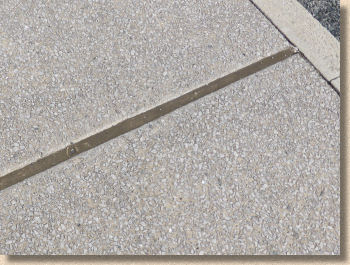
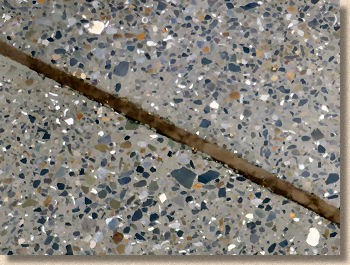
Fibreboard or 'compressible filler' joints are usually quite scruffy looking, and the soft nature of the material, which allows it to absorb expansion and contraction of the adjacent slabs, also means it will abrade and deteriorate relatively quickly.
Accordingly, on projects where the finished look is important, such as the polished concrete job shown opposite, the fibreboard will often be chopped out to a depth of 30mm or so and the joint topped with a flexible sealant.
The sealant is supplied in containers of various sizes, to suit the job in hand, with different sealants being used for different projects. Builders' Merchants will advise on the most appropriate sealant for a given project, if none is specified.
Before applying the sealant, the joint should be thoroughly cleaned to remove any laitance, dust or other deleterious matter. Grit blasting is the preferred method of cleaning a joint prior to sealing but a blast of very carefully aimed compressed air will usually work just as well on new joints.
Sealant tends to bond better to a dry joint and ought to be kept free from traffic for the first 24 hours. A temporary cover may be placed over the joint to prevent accidental trafficking.
Dowelled Joints
Where a large area is being covered with concrete, the slab is normally divided into a number of bays and adjacent bays are tied to each other by means of dowels, short lengths of steel bar embedded half in one bay and half in its neighbour.
In alternate bay construction, the dowels are positioned in the first bay and left protruding, to be concreted over when the second bay is poured. In continuous run concreting (CRCR), a highly mechanised form of concreting normally only used on the very largest projects such a major roads and runways, the dowels are auto-inserted into the concrete as it is laid and a joint wet-formed or cut as required.
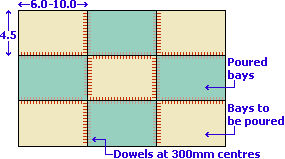
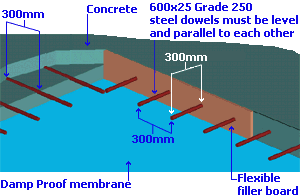
The dowels should be 600mm long and manufactured from mild steel (Grade 250). In expansion joints, the dowels are 25mm diamter at 300mm centres, but for contraction joints, the dowels may be slightly shorter, 400mm in length and 20mm diameter, again at 300mm centres.
It is essential that the dowels are aligned to be level with the plane of the slab and parallel to each other to avoid the creation of stresses within the slab when movement occurs.
Dowelled Expansion Joints
Expansion Joints consist of a flexible piece of compressible board, such as 'Flexcell', topped with a waterproof sealant and sandwiched between adjacent bays or between the concrete slab and another fixed object.
For a dowelled expansion joint, the dowel should be de-bonded to half-length to prevent it 'sticking' to the concrete and thereby limiting free movement. In heavy duty applications, such as roadways, the de-bonded half is sleeved and capped, or sheathed in plastic film, to ensure free movement. Provision must be made to support the dowels and maintain their accurate alignment while the first bay hardens.
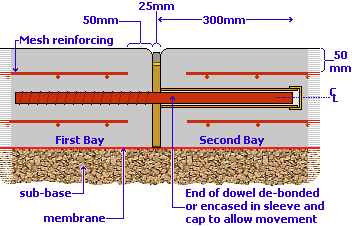
The flexible board will need to be drilled to accommodate the dowels and the edges of the expansion joint should be arrissed to prevent spalling. Once the second bay has hardened, the expansion joint can be sealed with a suitable sealant to prvent ingress of water, salts or detritus.
Dowelled Contraction Joints
With dowelled contraction joints, again the dowels are de-bonded to one half. In some cases, the sleeving will extend into the first bay so that when the completed joint is formed, the steel dowel is fully insulated from any water or salts that may find their way in to the joint.
The shutter has a temporary former attached at the top edge to create a gap that will eventually accommodate the joint sealant. The edge of the concrete is arrissed to prevent spalling.
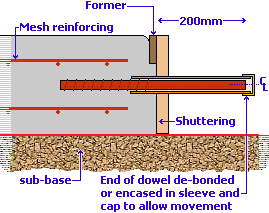
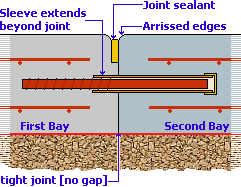
Once the first bay has hardened sufficiently and the former and shuttering has been removed, the second bay can be poured.
The tight joint between the adjacent bays generates a high degree of interlock between the aggregates.
After a period of hardening has been allowed for the second bay, the joint can be sealed with the appropriate sealant.
Dowelled Control Joints
Dowelled control joints (dummy joints) are most commonly used on highway and airport runway constructions, where continuous run concrete trains are used and the dowels can be automatically inserted.
A crack inducer at the base of the concrete slab may be incorporated and a 'starter' joint created by sawing at a critical point during the curing process or insertion of a wet-former when the concrete is placed.
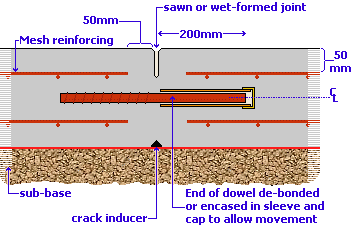
Non-dowelled Joints
Non-dowelled joints tend only to be found in light-use applications, such as residential paths, patios and driveways. There is a good argument for all joints to be dowelled unless there are extenuating circumstances, but site practice and tradition tends to follow the simplest, cheapest option when left to its own devices.
Expansion Joints
Non-dowelled expansion joints are not particularly common between two new concrete bays, but they are occasionally encountered as the joint between a new concrete slab and another fixed feature, such as a wall, as the wall (or other feature) is not capable of being dowelled.
This series of 3 diagrams illustrates the formation of an expansion joint between two new slabs, but the same principles apply for constructing an expansion joint between a wall and a slab.
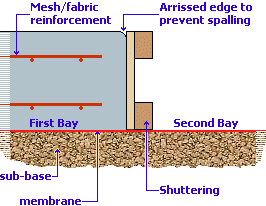
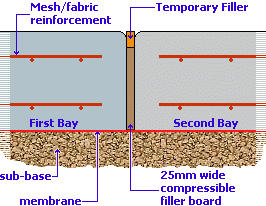
The flexible strips should be placed vertically against a solid edge, such as a wall or to the face of an already cast concrete slab and are typically set 30mm below the finished surface level of the concrete to accommodate the sealant and a bond-breaker, if one is specified. A temporary filler strip may be positioned on top of the flexi-board to keep the joint free of concrete during placement. This temporary filler strip is removed once the concrete has hardened to reveal the required gap for the sealant.
The top of the joint should be sealed with an appropriate sealant which is left slightly lower than the top of the joint.
When sealing an expansion joint between a slab and a wall, a cold-pour sealant applied via a mastic gun is the easiest option.
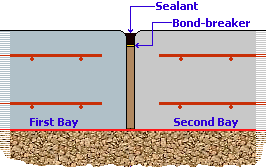
Contraction Joints
Contraction joints are the simplest of joints in that they are basically a break in the concrete and the reinforcement created to allow the natural shrinkage of concrete (because of curing and/or temperature change) to take place without generating crack-inducing tensile forces within the slab.
They are formed by embedding a 25×25mm timber or plastic joint-former into the still wet concrete, then removing it once hardening has taken place, and filling the void with a suitable sealant.

Crack Control Joints (Dummy Joints)
This type of joint is most commonly encountered on Pattern Imprinted Concrete paving, particularly residential driveways and patios.
For creation during construction, the control joints may be pre-formed using a timber strip and/or a Grooving Trowel. The inclusion of a crack inducer will help ensure cracking takes place in exactly the right place. Depending on the type of joint required, additional work may be necessary once the concrete has cured. If a timber or other temporary former has been used to create the wet-formed joint, it should be removed and the joint sealed with a suitable sealant, usually a polysulphide such as Thioflex.

Sawn joints are normally cut a week or more after sealing, so that the concrete will have had a reasonable amount of time to cure and avoid 'spalling' at the cut edges, and for the sealant to protect the surface from the concrete dust. On no account should concrete dust be allowed to rest on the surface for any length of time as it will set and could damage the surface when forcibly removed.
They are cut into the cured pavement using a power saw with diamond-blade, and should be between 25% and 33% of the depth of the slab. A trolley-mounted floor saw will ensure a neat and true cut is made; hand-held cut-off saws have a tendency to 'wobble' during the cutting operation, giving a cut with all the straightness of a dog's back leg. If a hand-held cut-off saw is the only option, a suitable guide rail should be used to keep the cut straight and true.

Construction Joints
As mentioned above, Construction Joints are breaks in the continuity of a concrete structure, rather than control features, such as Expansion, Contraction or Crack Control Joints, that is, they are there through necessity rather than because of any critical engineering consideration.
Day Joint
The simplest of all 'joints', so much so, it is often not even considered as a joint.
A Day Joint is simply one section of concrete lying immediately adjacent to or over another section of concrete. No formwork; no special preparation; no dowels or bars or anything else, just concrete-on-concrete.
Its name derives from the fact that one day's concrete work would lie directly against the previous or next day's work.
A classic example of a day joint is found with kerb laying. The kerbs are typically laid onto bed of concrete, aligned, checked for level, teased into the best line or curve, and then, some time later, maybe the same day or maybe the next, the haunching concrete is placed. The haunching is typically a higher slump than the bedding concrete.
And there it is: an unformed joint between bed and haunch - a Day Joint.
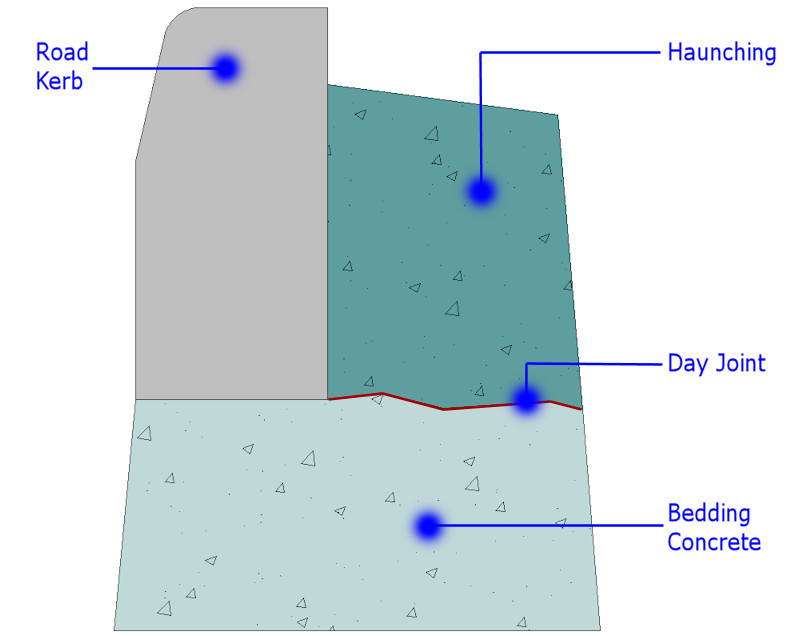
Simple Vertical Construction Joint
The most common reason for the existence of a Construction joint is the cessation of work for the day. Consider a large slab that is being poured as part of a road scheme: work cannot continue 24 hours per day, and so, when the end of a working shift is reach, the pour comes to an end, and this end, often known as a 'Stop End', 'Stunt End' or 'Day Joint', needs to be relatively neat and tidy so that work can be continued the following day, continuing on from the previous day's Stop End. The simplest form of a Construction Joint in such a scenario is shown opposite.
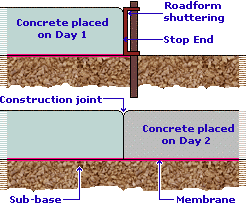
Joggle Joint
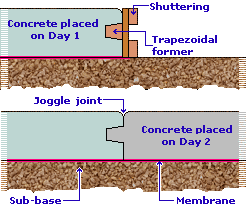
In some situations, it may be preferable to 'lock together' the slab across the construction joint in such a way that shearing forces can be transferred across the joint. Often, this would be done by means of some form of dowelled joint as described above , but an alternative is to use what is known as a 'Joggle Joint'.
There are various types or shapes of joggle joints. Some create a basic 'overlap' joint, and some may be square, rather than trapezoidal, but the simplest type, the one we've used most often, is shown here.
With this type of construction joint, a "trapezoidal key" is created in the stop end by using a 'former' attached to the stop end shuttering.
The former, which needs to be removed to facilitate subsequent pours, is often a shaped and planed length of timber, nailed to the shutter and painted with Mould Release Agent (Soap Oil).
Once placement resumes, plastic concrete flows into the void created by the former and the new work is 'tied' to that of the previous day.
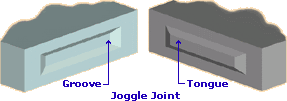
Construction Joint with Starter Bars
Another fairly common construction joint utilises what are known as 'Starter Bars' to tie together separate pours. The Starter Bars are usually 600mm long and 12-20mm diameter steel dowels, although, in some cases, steel mesh may be used. The bars, usually at 450-600mm centres, are inserted into the plastic stop end to half their depth at the end of the day. The follow-on work, when it happens, encases the protruding half of the dowels, thereby locking together the two bays.
It may appear that this type of joint is remarkably similar to the dowelled expansion joint illustrated above , but it should be noted that no accommodation has been made for expansion or other movement, and that this is a significantly inferior joint, from an engineer's point of view, to that shown previously.
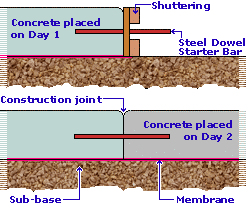

While the value of this particular form of joint with starter bars may be less obvious on horizontal slabwork, its use is a regular feature of vertical masonry, where a concrete wall or retainer may need to be poured in a number of sections or 'lifts', with each section tied to the previous for structural integrity.
When used on vertical structures, the joint itself is, naturally horizontal, and may accrue standing water or laitance if left exposed to the elements for any period of time. It is therefore essential that the surface of the joint is thoroughly cleaned with a wire brush or a scabbler tool prior to the placement of subsequent lifts.
Simple Horizontal Construction Joint
This type of construction joint is most commonly found in minor civil engineering works. the example shown here is from the construction of a manhole chamber . The base concrete is placed first, and may be left for a period of time or may have the first chamber section placed and levelled, or one or two courses of engineering brickwork laid more or less immediately. Some time later, the channel and its immediate haunching may be placed, further chamber sections or brickwork added as required to bring up the chamber to soffit level , and the external haunching concrete put in place. This will result is a simple, horizontal construction joint at the interface of the two phases of work.
